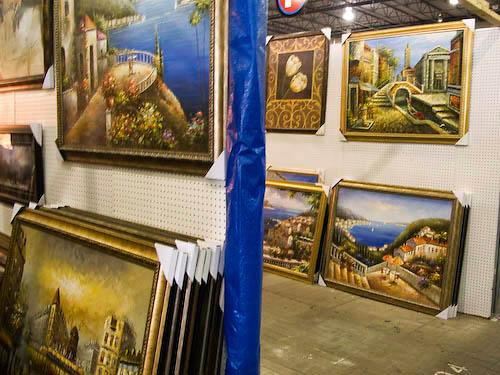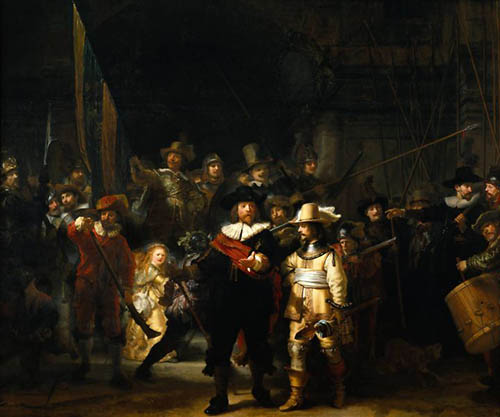The Art of Seeing Art
Version 1.1, © 2007 by Dale Cotton, all rights reserved.
Part 2: Beginnings
Part 2 and the rest of this series is targeted at the non-artist and will serve as a quick overview of the visual art microcosm – the bare bones of an Art Appreciation 101 course. If you took such a course in school, think of it as a refresher.
Art appreciation is like learning to ride a bicycle. Once you get to the right age, a few words of instruction, a steadying hand, plus a small push will get you going. The rest comes from riding around.
My motivation here is entirely selfish. People are of course free to like, dislike, or remain indifferent to my pictures; but I want them to do so for what I feel are the right reasons. I assume other artists feel the same way.
What is art?
This seems one of those open-ended questions that can be debated from here to eternity, but the answer is actually quite simple:
Art is anything you can get away with.
– Joseph Campbell
That may sound flip, but it's also the plain truth. What we want to say is that art has something to do with beauty, truth, and craftsmanship – but recent history has proven this wrong. (Don't like it? Vote with your wallet.)
Why art?
Recently I spent half an hour wandering the aisles of a local indoor flea market – the modern equivalent of the outdoor bazaar with a tent or stall for each merchant. The number of stalls devoted to pictures has decreased since my last visit a few years ago but the fact that there are any at all is itself worthy of note. In fact, many of the wares I saw serve no other function than decoration – although admittedly more often decoration of the body, as in jewelry or a printed t-shirt.
We know that decoration has been scratched or painted on manufactured objects and cave walls for all the 50,000 years that homo sapiens has graced the planet. We now know that one of the primary mutations that created the homo sapiens species results in our hugely over-grown visual cortex. Apparently, we have so much excess visual processing capacity that where visual complexity is missing we feel compelled to supply it.

Fig. 1: Flea market art
What we now call art surely grew out of this decoration compulsion. Functionally, the walls of our homes might as well be bare but for our need for continual and massive doses of visual input. Nevertheless, decoration is not necessarily about beautification. This is a distinction that an artist may have a great deal of trouble grasping. A large subset of the male population, for example, is far more interested in tokens of power than in beauty. A tattoo or body painting can be colorful zig-zags or curliques; it can also be a flaming sword or a gang emblem.
Power is about using – exploiting – the world. Martin Buber wrote a whole book exploring the dichotomy between using and participating in the world. Evolution gifted us with an incredible visual sub-system, but the shaping force of that evolution was survival and dominance, not poetry and grace. Yet power can be combined with poetry and the result can stir even the male soul. Few objects do this better than the styling of a modern vehicle:

Fig. 2: Functional sculpture
Yet another influence that has often been assumed for the early origins of art is the religious impulse: the desire to better one's lot by currying favour from, appeasing the anger of, or otherwise manipulating the forces of nature, however personified. The cave paintings of Lascaux demonstrate a sophisticated and subtle aesthetic that seems to come out of nowhere, but various factors suggest their principle purpose may have been neither beautification nor record-keeping, but something more akin to sympathetic magic. More recently the mandala is an example of meditative art, the purpose of which is to open the inner eye of the meditating observer.
Observing the observers
Fast-forward a few thousand years to the present day. If art started out as a integral part of the human experience ... what happened? The short answer is the rise of the modern concept of art for art's sake. If for most of human history visual art served pragmatic purposes such as creating tokens of power and religious influence, in our time much of art has returned to its earliest function of decoration ... then shot off in yet another direction.
The next time you're at a gallery, an art museum, or an art show of any sort take a few minutes to observe your fellow observers. Notice how many have arms folded across their chests or otherwise present a judgmental posture. In part, the very mechanics of flat art enforce this. Pictures are hung on walls, forcing us to stand or sit at a physical distance in order to "take them in".
Also notice how many have creased brows, looks of serious concentration, or even frowns. What we still call modern art too often seems no longer about enriching the visual environment with images of beauty or tokens of power conferred upon the viewer, but rather are dominance games that attempt to confer power to the artist. The underlying statement too often suggests an artist who is saying: "I am clever and deep. Are you up to the challenge?"
Yet even if the art being shown is purely representational (or at least harmlessly impressionistic), you're still likely to observe the judgmental stance and concentrated expressions in your fellow observers. A Rembrandt may sell for millions of dollars, sending a message to the public that reinforces the same message they got in school. "Serious" art is done by "geniuses" and is therefore imbued with subtleties that the average person may never be able to discern. Your fellow art show attendee is very likely involved in a desperate effort to experience a bit of this magic – the subject of next week's episode in this series.
